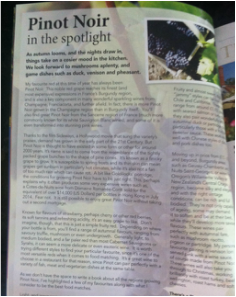 Pinot Noir in Neuchatel
Pinot Noir in Neuchatel My favourite red at this time of year has always been Pinot Noir. This noble red grape reaches its finest (and most expensive) expressions in France’s Burgundy (Bourgogne) region, and is also a key component in many wonderful sparkling wines from Champagne, Franciacorta, and further afield. In fact, there is more Pinot Noir grown in the Champagne region than in Burgundy itself. You’ll also find great Pinot Noir from the Sancerre region of France (much more commonly known for its white Sauvignon Blanc wines), and some of it is even transformed into stunning pink wines.
| Thanks to the film Sideways, a Hollywood movie that sung the variety’s praises, as well as singlehandedly causing a massive drop in street credibility for Merlot, demand has grown in the early part of the 21st Century. | Pinot Noir is no new kid on the block, though. Thought to have existed in some form or other for around 2000 years, it’s name is said to come from the resemblance of the tightly packed grape bunches to the shape of pine cones. (See photo above). It's known as a finicky grape to grow, being susceptible to spring frosts, having a thin skin meaning grapes get sunburn in particularly hot climates, while it’s also not a fan of too much rain which can cause rot. A bit like Goldilocks’ porridge, the conditions for growing Pinot Noir have to be just right. This, perhaps explains why it often produces some very expensive wines indeed. For example, a Cotes-de-Nuits wine from Domaine Romanée-Conti sold for the equivalent of over $14000 (US Dollars) per bottles in Hong Kong in July 2014. Fear not. It is still possible to enjoy great Pinot Noir without taking out a second mortgage. My mission is to encourage you to try some! |
 I wrote a version of this article for Vivid magazine Sept/Oct 2015
I wrote a version of this article for Vivid magazine Sept/Oct 2015 This versatility makes it a great wine to choose in a restaurant, since Pinot can pair perfectly with a variety of fish, meat and vegetarian dishes at the same table.
We don’t have the space for the book it would to detail all the regions growing Pinot Noir and their variations. Several volumes could be (and probably have been) written just on the regions of Burgundy’s Cote d’Or. I’ve highlighted below a few of my favourites, along with their best food matches. And if you're interested, I've also written many blog posts on my favourites.
 A couple of decent new world PNs from Waitrose & M&S
A couple of decent new world PNs from Waitrose & M&S Fruity and almost sweet, slightly “jammy” styles can be found from Chile and California. These can range from around £7-15. Ideal with seared salmon or tuna dishes, they also pair wonderfully with autumnal duck or partridge dishes, particularly those with a fruity or sweeter sauce. These work really well with Chinese styles of duck and pork dishes too.
Silky, elegant, rich, and complex
Moving up in price from £15 - £50 and beyond, Burgundy areas such as Gevrey-Chambertin and Nuits-Saint-Georges, or wines from Oregon’s Willamette Valley or New Zealand’s Central Otago region, become silky and elegant, and with the right vintage conditions, can even be rich and full bodied. They’re not only capable of ageing, some may demand it to soften and be at their best, when they’ll develop more savoury flavours. These wines pair perfectly with autumnal fare, such as mushroom risotto, pigeon or partridge. My personal favourite pairing is venison loin served pink with a wine sauce, of course made from Pinot Noir. These wines will also take you through to Christmas, working brilliantly with roast turkey, beef wellington, roast hams and soft cheeses.
There’s a Pinot Noir out there for every budget and every palate, so what are you waiting for?
Peruse the Pinots till you find your perfect pairing.
And please do let us know about your personal Pinot preferences. I've got several on my wine rack at the moment, so I'm sure I'll be sharing more very soon.


 RSS Feed
RSS Feed
